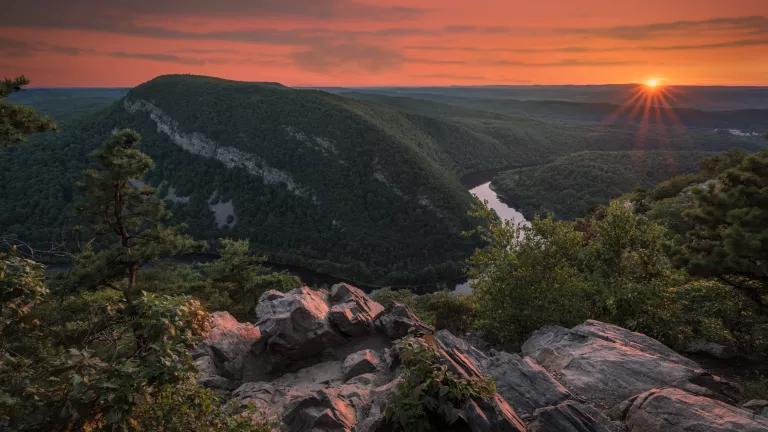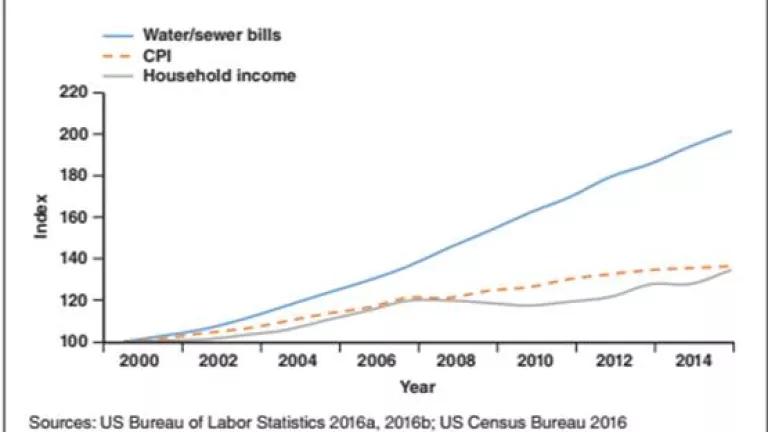Clean Water Delayed Is Clean Water Denied: After a Decades-Long Dodge, EPA Must Update Polluted Runoff Rules
A long time ago, in a galaxy far, far away…
No, make that Washington, DC, in the year 1987. (Perhaps that is another galaxy. But that’s a topic for another blog.)
Way back then—more than a quarter-century ago—Congress passed a law directing the Environmental Protection Agency to create a new program to protect our nation’s waters from stormwater pollution. Stormwater is the dirty runoff that washes off of developed land, after rainstorms and snowmelt, carrying toxic metals, pesticides, excess nutrients and sediment, and even harmful bacteria into waters nationwide. Unlike pollution from factories, EPA had failed to develop pollution control standards for this ubiquitous form of water pollution.
When Congress acted, stormwater represented—and still represents today—one of the largest sources of water pollution in this country. The dirty water that runs off roads, parking lots and other hard surfaces in cities and suburbs when it rains is the prime cause of beach closings around the country, and is responsible for fouling tens of thousands of miles of streams, hundreds of thousands of acres of lakes, ponds, and reservoirs, and thousands of square miles of coastal waters. In addition, sediment-laden runoff from forest roads threatens drinking water supplies and kills fish and other aquatic life.
Congress needed to act because EPA consistently dragged its feet on this issue, something that unfortunately has continued even after the law changed. Congress responded in 1987 to earlier court decisions dating to at least 1977, which ruled that the Clean Water Act (passed in 1972) required EPA to regulate stormwater pollution. In amending the law 27 years ago, Congress set a deadline of 1992—later extended to 1993—for EPA to adopt an effective program for stormwater. Six years after the deadline, in 1999, EPA adopted a final regulation. Four years after that, in 2003, a federal appeals court sent those regulations back to EPA to strengthen them, because they weren’t up to the standards set by Congress. NRDC and Environmental Defense Center (EDC) filed the lawsuit that yielded that court decision.
Now, NRDC and EDC are going back to court (the court papers are available here), because EPA’s failure to act has continued for more than a decade after the court ruled.
Below, I describe EPA’s recent history of ducking responsibility for developing needed control programs for polluted runoff and explain the importance of our action to enforce the law now. In brief summary, the 2003 court decision and our action now to enforce it focus on polluted runoff from urbanized areas and from forest roads, both of which are badly in need of more effective regulation. Unfortunately, although EPA, in recent years, had promised to improve its nationwide stormwater rules, and even initiated work towards doing so, it abandoned those efforts.
What Did the Court Say About Polluted Urban Runoff, and What Happened Afterwards?
In 2003, the court ruled that EPA’s regulations for “small” municipal storm sewer systems (serving under 100,000 residents) unlawfully allowed those systems to make their own rules, without oversight from state and federal agencies or from the public. As the court explained, such oversight is necessary to ensure that these sewer systems meet Congress’s command to reduce their pollution discharges “to the maximum extent practicable.”
Several years later, EPA commissioned a study by the National Research Council (known as the NRC, an arm of the prestigious National Academies of Science). This comprehensive review recommended wholesale changes in the way EPA regulates polluted urban runoff. The 500-page report, co-authored by fifteen nationally-recognized scientific experts, was a damning indictment of EPA’s current regulatory scheme. It was, effectively, a dossier on the consequences of EPA’s failure to comply with the court’s order to revise the regulations:
EPA’s program has monitoring requirements that are so benign as to be of little use for the purposes of program compliance. Most dischargers have no measurable, enforceable requirements. Instead, the stormwater permits leave a great deal of discretion to the regulated community to set their own standards, develop their own pollution control schemes, and to self-monitor. Current statistics on the states’ implementation of the stormwater program, compliance with stormwater requirements, and the ability of states and EPA to incorporate stormwater permits with pollution limits are uniformly discouraging.
Significant changes to the current regulatory program are necessary to provide meaningful regulation of stormwater dischargers in the future.
The NRC study led the agency to initiate a rulemaking process to modernize its national stormwater rules. In doing so, EPA expressly cited the NRC’s recommendations to re-orient stormwater regulation around minimizing impervious area—which reduces the amount of polluted runoff in the first instance—and capturing most of the remaining runoff onsite with “green infrastructure”—so it never reaches city sewers or waterways. NRDC and other observers also expected the new rules to address the Ninth Circuit’s court order.
After plodding along for four-and-a-half years, and under heavy pressure from developers, EPA pulled the plug entirely on that rulemaking in early 2014.
That decision not only prolonged EPA’s decade of ignoring the federal appeals court ruling. It also represents a failure to ensure that cities, suburbs, and developers use the best available practices for reducing stormwater pollution.
Green infrastructure solutions—like rain gardens, roadside plantings, green roofs, and permeable pavement—stop rain where it falls, and store it for other uses, allow it to evaporate back into the atmosphere, or let it filter into the ground, where it can nourish green space and replenish groundwater supplies. This prevents it from picking up pollution from paved surfaces and polluting our waters.
An increasing number of cities around the country are using green infrastructure to address stormwater pollution. These communities reap the added benefits of beautifying neighborhoods, cooling and cleansing the air, reducing asthma and heat-related illnesses, reducing energy demand for heating and cooling, and creating “green-collar” jobs. And green infrastructure can provide millions of dollars in benefits to individual property owners as well.
But only EPA has the ability to set nationwide rules making this green approach the norm—rules that are sorely needed to restore our nation’s waters to health. Instead, the agency seems to have caved to political pressure, leaving in place the rules that have failed to work for our communities and our waters.
What Did the Court Say About Pollution from Forest Roads, and What Happened Afterwards?
The second aspect of the Ninth Circuit’s 2003 decision, and of our action now, has to do with forest roads. Especially throughout the west (but in the east as well), sediment eroding from these roads is a major threat to water quality, undermining the billions of dollars we are investing in the recovery of native runs of salmon and steelhead, and harming valuable commercial and recreational fisheries, not to mention drinking water supplies.
The court ordered EPA to consider all relevant evidence and make a determination as to whether regulation of forest rood runoff is necessary. Nine years later, EPA announced in 2012—in the course of exempting forest roads from one set of regulations—that it was considering new options for regulating forest road runoff. However, more recent EPA statements acknowledge that the agency has no particular timeline in mind to make a decision, other than “long-term.” But, following the Ninth Circuit’s order in 2003, long-term has long since passed.
There are many known, effective ways to significantly reduce polluted runoff from forest roads. But, without EPA regulations, these practices will continue to be under-utilized and our waters will suffer for it.
What Did NRDC Just Do?
That brings us to today. It’s 2014, more than 11 years after the court ordered EPA to act, and nearly thirty years after Congress originally instructed EPA to act. Remarkably, EPA still hasn’t fixed the stormwater rule. Indeed, the agency hasn’t even really tried.
So, NRDC and EDC filed suit again, asking the federal court impose specific deadlines on EPA to implement the 2003 court order. Specifically, we asked the court to order EPA to:
- issue new rules on urban stormwater permits within one year;
- make a formal determination within six months on whether regulation of forest road runoff is necessary; and
- if the agency finds forest road regulations necessary (which we are convinced they are), issue such rules within two years after that.
Our rivers, lakes, beaches, and bays—and all of us who rely on them for drinking water, livelihood, and recreation—can’t afford to wait any longer for EPA to act.
We believe the court—having been ignored by EPA for a decade—will see it the same way. And, however the court responds, EPA needs to get back to doing its job: Using the legal authority Congress directed it to use, and the recommendations of our nation’s leading scientific experts, to protect our waters from polluted runoff.
The solutions are at hand. It’s up to EPA and the courts to act.




